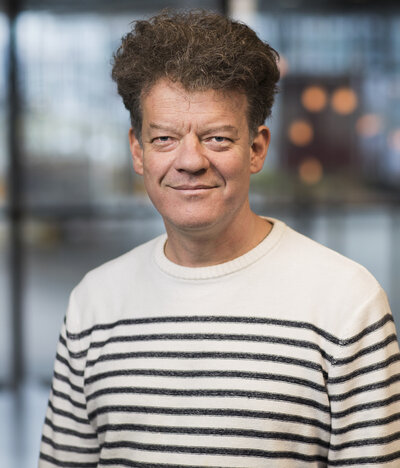Arno Pronk
Department / Institute

RESEARCH PROFILE
My expertise lies in the development and application of environmentally related innovations in experimental structures and buildings. Below is a list of the most important projects: In 2021 Springer will publish a 500-page book entitled Flexible Forming for Fluid Architecture. In 1996, in collaboration with Geelen Beton and buro A +, I developed the adaptable Slimline ® floor that makes it possible to adapt buildings in a simple way during their lifetime. With this patented floor system I designed and realized the first office building. This system was used to build the European Patent Office designed by Jean Novel in Rijswijk (NL) and the Kraanspoor designed by Tudo Hooykaas in Amsterdam. In 2001 and 2003 I realized a stage cover and pavilion with the combination of inflatable molds and composites. In 2003 I realized a directly cooled igloo. The development of this innovation has resulted in a significant reduction in the use of energy compared to conventional refrigerated systems and resulted in three patents. In 2005 and 2006, I developed an inflatable pavilion and an inflatable ring for the 60th anniversary of the TU/e. In 2006 I developed a system for the realization of shell constructions with shotcrete which has been patented. With this system, a prototype was made for the rebuilding of the Philips pavilion (1958) designed by Le Corbusier, a cross vault in Kelpen (2009) and a shell structure designed by Massimiliano Fucsas in Eindhoven (2008). In 2005, 2012 and 2016, various innovative facade systems were developed with a focus on climate control. In 2013 I developed a motorcycle on LPG for 3 people. This motorcycle has been approved by the Rijksdienst Wegverkeer (RDW) in the Netherlands. I developed an autarkic installation concept for a harbor building (2013) and houseboat (2010). Between 2008 and 2016 I researched flexible moulding technology for producing curved structures in concrete, glass, composite and ice. The company ADAPA in Denmark has successfully explored one of these systems to realize the Museum of the Future in Dubai. In the period 2014-2016, various kinetic light support structures with solar panels were designed and constructed. With these systems it is possible to make dual-axis sun tracking. In 2017 I have designed and realized a moving foldable stage. With regard to circular construction, I realized two homes in Amsterdam in 2018 from wooden molds which were leftovers from the concrete industry. Since 2014, I have designed and realized a number of groundbreaking constructions with fiber-reinforced ice, such as the largest igloo with a span of 29.1 meters, the highest thin shell ice structure with a height of 30.5 meters and the first 3D printed grid shell of ice composites. For the Olympic Winter Games in 2022, I have made a proposal that i hope to realize. At the moment my research is focused on molding technology with ice. https://www.flickr.com/photos/185969471@N04/albums/72157712162227506/page3 This has large environmental benefits because ice compared to conventional materials emits 80% less CO2 despite the energy required for it. Another current research topic is a new material and technique developed by Boskalis. With this invention it is possible to print very complex structural optimized shapes that are usually not possible with 3D printing equipment.
You can also have a look at marktplaats https://www.marktplaats.nl/my-account/sell/index.html
ACADEMIC BACKGROUND
Arno Pronk graduated as an architect at the TU Delft Faculty of Architecture in 1994. During his studies he explored both sculptural art and technical innovation. After his studies, not only did he work as an architect but also as a designing technician. His technical interest had been developed further during a two-year post-graduate course at the chair Product Development (TU Delft). In cooperation with Professor Lichtenberg (TU/e) he developed a patented flooring system, which was successfully introduced on the Dutch market and used in several high-profile buildings (among others Kraanspoor in Amsterdam and the European Patent office by Jean Novel). He had two years’ experience as an assistant professor at TU Delft, 12 years of experience in the same job at the Eindhoven University of Technology (0.8 FTE) and in addition in the past seven years as a lecturer on material science at KU Leuven Faculty of Architecture (0.2 FTE). His PhD research on flexible moulding for fluid architecture connects fluid architecture with technology. It is a summary of the intensive and long-lasting research in flexible forming with different techniques and materials. It has resulted in the realization of several projects and technologies. In addition to practical projects, he has organized several international workshops and conferences. The biggest ones were Adaptables (2006), Bridges Leeuwarden (2008) and IASS Amsterdam (2015). In 2017 he became the chair of IASS workgroup 21 about advanced manufacturing and materials.
Recent Publications
-
Arno D.C. Pronk,Guido Visch
Buoycrete, a light-weight concrete in combination with a membrane mold
(2023) -
Arno D.C. Pronk
Reuse of materials for the built environment
(2023) -
Arno D.C. Pronk
PV Sun tracking
(2023) -
Arno D.C. Pronk
Reuse of a container for dwellings
(2023) -
Arno D.C. Pronk
Reuse of Chopsticks
(2023)
Ancillary Activities
No ancillary activities